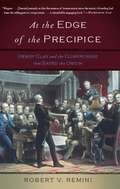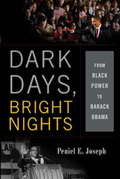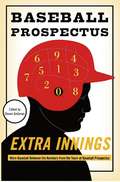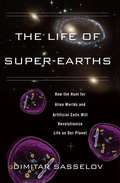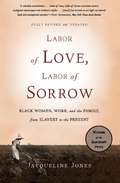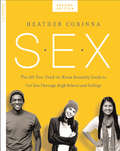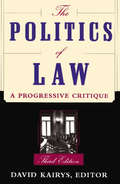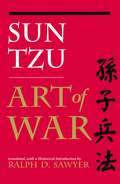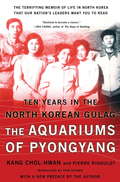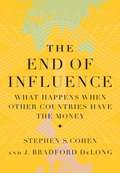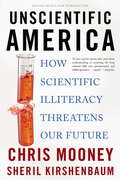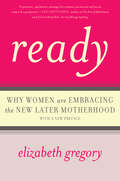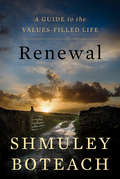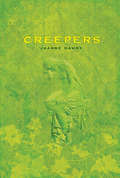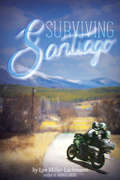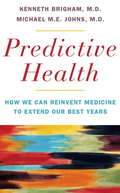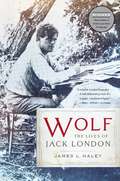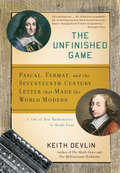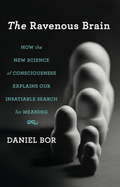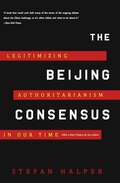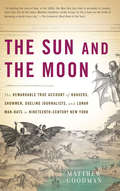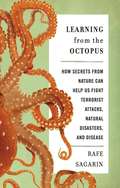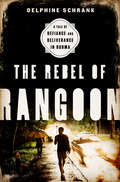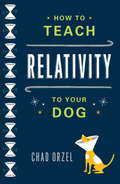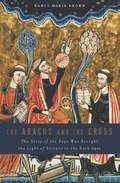- Table View
- List View
At the Edge of the Precipice: Henry Clay and the Compromise That Saved the Union
by Robert V. ReminiIn 1850, America hovered on the brink of disunion. Tensions between slave-holders and abolitionists mounted, as the debate over slavery grew rancorous. An influx of new territory prompted Northern politicians to demand that new states remain free; in response, Southerners baldly threatened to secede from the Union. Only Henry Clay could keep the nation together.At the Edge of the Precipice is historian Robert V. Remini's fascinating recounting of the Compromise of 1850, a titanic act of political will that only a skillful statesman like Clay could broker. Although the Compromise would collapse ten years later, plunging the nation into civil war, Clay's victory in 1850 ultimately saved the Union by giving the North an extra decade to industrialize and prepare. A masterful narrative by an eminent historian, At the Edge of the Precipice also offers a timely reminder of the importance of bipartisanship in a bellicose age.
Dark Days, Bright Nights: From Black Power to Barack Obama
by Peniel E. JosephThe Civil Rights Movement is now remembered as a long-lost era, which came to an end along with the idealism of the 1960s. In Dark Days, Bright Nights, acclaimed scholar Peniel E. Joseph puts this pat assessment to the test, showing the 60s -- particularly the tumultuous period after the passage of the 1965 Voting Rights Act -- to be the catalyst of a movement that culminated in the inauguration of Barack Obama. Joseph argues that the 1965 Voting Rights Act burst a dam holding back radical democratic impulses. This political explosion initially took the form of the Black Power Movement, conventionally adjudged a failure. Joseph resurrects the movement to elucidate its unfairly forgotten achievements. Told through the lives of activists, intellectuals, and artists, including Malcolm X, Huey P. Newton, Amiri Baraka, Tupac Shakur, and Barack Obama, Dark Days, Bright Nights will make coherent a fraught half-century of struggle, reassessing its impact on American democracy and the larger world.
Extra Innings: More Baseball Between the Numbers from the Team at Baseball Prospectus
by The Baseball ProspectusIn 1996, a brassy young team of fansproduced a guide to baseball statistics.Printed on a photocopier, its distribution,which was in the low hundreds, was limited tofriends, family, and die-hard stat heads. Sixteenyears later, the Baseball Prospectus annualregularly hits best-seller lists and has becomean indispensable guide for the serious fan. In Extra Innings, the team at Baseball Prospectusintegrates statistics, interviews, and analysis todeliver twenty arguments about today's game.In the tradition of their seminal book, BaseballBetween the Numbers, they take on everything fromsteroids to the amateur draft. They probe theimpact of managers on the game. They explainthe critical art of building a bullpen. In an erawhen statistics matter more than ever, Extra Inningsis an essential volume for every baseball fan.
The Life of Super-Earths: How the Hunt for Alien Worlds and Artificial Cells Will Revolutionize Life on Our Planet
by Dimitar SasselovIn 1543, Nicolaus Copernicus fomented a revolution when he debunked the geocentric view of the universe, proving instead that our planet wasn&’t central to the universe. Almost five hundred years later, the revolution he set in motion is nearly complete. Just as earth is not the center of things, the life on it, it appears, is not unique to the planet. Or is it? The Life of Super-Earths is a breathtaking tour of current efforts to answer the age-old question: Are we alone in the universe? Astronomer Dimitar Sasselov, the founding director of Harvard University&’s Origins of Life Initiative, takes us on a fast-paced hunt for habitable planets and alien life forms. He shows how the search for &“super-Earths&”—rocky planets like our own that orbit other stars—may provide the key to answering essential questions about the origins of life here and elsewhere. That is, if we don&’t find the answers to those questions here first. As Sasselov and other astronomers have uncovered planets with mixes of elements different from our own, chemists have begun working out the heretofore unseen biochemistries that those planets could support. That knowledge is feeding directly into synthetic biology—the effort to build wholly novel forms of life—making it likely that we will first discover truly &“alien&” life forms in an earthly lab, rather than on a remote planet thousands of light years away. Sasselov tells the gripping story of a moment of unprecedented potential—a convergence of pioneering efforts in astronomy and biology to peer into the unknown. The Life of Super-Earths offers nothing short of a transformation in our understanding of life and its place in the cosmos.
Labor of Love, Labor of Sorrow: Black Women, Work, and the Family, from Slavery to the Present
by Jacqueline JonesThe forces that shaped the institution of slavery in the American South endured, albeit in altered form, long after slavery was abolished. Toiling in sweltering Virginia tobacco factories or in the kitchens of white families in Chicago, black women felt a stultifying combination of racial discrimination and sexual prejudice. And yet, in their efforts to sustain family ties, they shared a common purpose with wives and mothers of all classes.In Labor of Love, Labor of Sorrow, historian Jacqueline Jones offers a powerful account of the changing role of black women, lending a voice to an unsung struggle from the depths of slavery to the ongoing fight for civil rights.
S.E.X., second edition: The All-You-Need-To-Know Sexuality Guide to Get You Through Your Teens and Twenties
by Heather CorinnaThe go-to sex ed guide for teens and young adults, tackling everything you want to know about sex, from consent, safe sex, emotional health and more, from the founder of scarleteen.com. As a teen or emerging adult, dealing with all the changes going on in your life, body, and mind can be mighty overwhelming. When it comes to sex, everyone seems to have strong feelings and opinions about who you should be and what you should (shouldn't) do. How do you decide who to listen to? Heather Corinna and Scarleteen have provided sex education and information to millions of young people, parents, and mentors since 1998; S.E.X. tackles all the big topics:Self-image and how to find and claim your own sexual selfHow to best protect and support your sexual and emotional healthSorting out gender and sexual identities, even when they're complicated and confusingThe latest on contraceptive methods and other reproductive choices, sexually transmitted infections, and safer sexFinding, creating, and managing healthy and happy relationshipsHow to set and respect limits and boundaries, and rock consentIdentifying, preventing, or healing from abuse or assault...and much more. Whatever your gender or sexual identity, whether you've already been actively exploring your sexuality or are only just getting curious, S.E.X clearly spells out what you need and want to know--no shame, no judgement, just comprehensive and accurate info in a clear, straightforward language.
The Politics Of Law: A Progressive Critique, Third Edition
by David KairysThe Politics of Law is the most widely read critique of the nature and role of the law in American society. This revised edition continues the book's concrete focus on the major subjects and fields of law. New essays on emerging fields and the latest trends and cases have been added to updated versions of the now-classic essays from earlier editions.A unique assortment of leading scholars and practitioners in law and related disciplines-political science, economics, sociology, criminology, history, and literature-raise basic questions about law, challenging long-held ideals like the separation of law from politics, economics, religion, and culture. They address such issues contextually and with a keen historical perspective as they explain and critique the law in a broad range of areas.This third edition contains essays on all of the subjects covered in the first year of law school while continuing the book's tradition of accessibility to non-law-trained readers. Insightful and powerful, The Politics of Law makes sense of the debates about judicial restraint and the range of legal controversies so central to American public life and culture.
The Art of War: Sun Tzu's Classic In Plain English With Sun Pin's The Art Of Warfare (Penguin Modern Classics Ser. #909)
by Tzu SunThe definitive translation of Sun-tzu's timeless classic of military strategy, Art of WarArt of War is almost certainly the most famous study of strategy ever written and has had an extraordinary influence on the history of warfare. The principles Sun-tzu expounded were utilized brilliantly by such great Asian war leaders as Mao Tse-tung, Giap, and Yamamoto. First translated two hundred years ago by a French missionary, Sun-tzu's Art of War has been credited with influencing Napoleon, the German General Staff, and even the planning for Desert Storm. Many Japanese companies make this book required reading for their key executives. And increasingly, Western businesspeople and others are turning to the Art of War for inspiration and advice on how to succeed in competitive situations of all kinds. Unlike most editions of Sun-tzu currently available (many simply retreads of older, flawed translations), this superb translation makes use of the best available classical Chinese manuscripts, including the ancient "tomb text" version discovered by archaeologists at Linyi, China. Ralph Sawyer, an outstanding Western scholar of ancient Chinese warfare and a successful businessman in his own right, places this classic work of strategy in its proper historical context. Sawyer supplies a portrait of Sun-tzu's era and outlines several battles of the period that may have either influenced Sun-tzu or been conducted by him. While appreciative of the philosophical richness of the Art of War, this edition stresses Sun-tzu's practical origins and presents a translation that is both accurate and accessible.
The Aquariums of Pyongyang: Ten Years in the North Korean Gulag
by Pierre Rigoulot Chol-hwan Kang"Destined to become a classic" (Iris Chang, author of The Rape of Nanking), this harrowing memoir of life inside North Korea was the first account to emerge from the notoriously secretive country -- and it remains one of the most terrifying. Amid escalating nuclear tensions, Kim Jong-un and North Korea's other leaders have kept a tight grasp on their one-party state, quashing any nascent opposition movements and sending all suspected dissidents to its brutal concentration camps for "re-education." Kang Chol-Hwan is the first survivor of one of these camps to escape and tell his story to the world, documenting the extreme conditions in these gulags and providing a personal insight into life in North Korea. Sent to the notorious labor camp Yodok when he was nine years old, Kang observed frequent public executions and endured forced labor and near-starvation rations for ten years. In 1992, he escaped to South Korea, where he found God and now advocates for human rights in North Korea.Part horror story, part historical document, part memoir, part political tract, this book brings together unassailable firsthand experience, setting one young man's personal suffering in the wider context of modern history, giving eyewitness proof to the abuses perpetrated by the North Korean regime.
The End of Influence: What Happens When Other Countries Have the Money
by Stephen S. Cohen J. Bradford DeLongAt the end of World War II, the United States had all the money—and all the power. Now, America finds itself cash poor, and to a great extent power follows money. In The End of Influence, renowned economic analysts Stephen S. Cohen and J. Bradford DeLong explore the grave consequences this loss will have for America&’s place in the world. America, Cohen and DeLong argue, will no longer be the world&’s hyperpower. It will no longer wield soft cultural power or dictate a monolithic foreign policy. More damaging, though, is the blow to the world&’s ability to innovate economically, financially, and politically. Cohen and DeLong also explore American&’s complicated relationship with China, the misunderstood role of sovereign wealth funds, and the return of state-led capitalism. An essential read for anyone interested in how global economics and finance interact with national policy, The End of Influence explains the far-reaching and potentially long-lasting but little-noted consequences of our great fiscal crisis.
Unscientific America: How Scientific Illiteracy Threatens our Future
by Chris Mooney Sheril KirshenbaumClimate change, the energy crisis, nuclear proliferation-many of the most urgent problems of the twenty-first century require scientific solutions, yet America is paying less and less attention to scientists. For every five hours of cable news, less than one minute is devoted to science, and the number of newspapers with science sections has shrunk from ninety-five to thirty-three in the last twenty years. In Unscientific America, journalist and best-selling author Chris Mooney and scientist Sheril Kirshenbaum explain this dangerous state of affairs, proposing a broad array of initiatives that could reverse the current trend.An impassioned call to arms, Unscientific America exhorts Americans to reintegrate science into public discourse-before it is too late.
Ready: Why Women Are Embracing the New Later Motherhood
by Elizabeth GregoryOver the past three decades, skyrocketing numbers of women have chosen to start their families in their late thirties and early forties. Women now have the option to define for themselves when they are ready for a family, rather than sticking to a schedule set by social convention. In Ready, Elizabeth Gregory tracks the burgeoning trend of new later motherhood and demonstrates that waiting to have children has made many women better mothers thanks to increased self-awareness, greater financial power, and an ability to focus more on their families. Drawing on statistical evidence and in-depth interviews with more than 100 moms, Ready shatters the alarmist myths surrounding later motherhood. Without ignoring the complexities older women may face in their quest to have children, Gregory delivers surprising and welcome news that revolutionizes the way we think about motherhood. The 2012 paperback adds a new Preface bringing the data and analysis up to the moment: encompassing discussion of the recessionary birth rate drop among younger women and its longterm effect on the later motherhood trend, the intersections between the War on Women's Reproductive Choice and the US's family-unfriendly policies with the trend to delaying kids, the dynamics of fertility scaremongering, and the competing pro-natalist and anti-natalist pressures on American women today. The Preface also introduces new data from a range of researchers on the positive effects of delay on women's wages, long-term happiness, and political clout. This book examines the full range of pressures shaping women's fertility decisions today, and begins from the assumption that women's choices make sense, for them and for their families.
Renewal: A Guide to the Values-Filled Life
by Shmuley BoteachOur culture is showing the cracks of a growing fracture. Soaring divorce rates; a crippled economy that rewards the few and punishes the many; religious-fueled hatred; record rates of depression—the headlines paint a grim picture. We inhabit a society that desperately needs fixing. But as Rabbi Shmuley Boteach reveals in his new book, Renewal, our society can made whole again when we as individuals make the choice to live a life based on values. For too long, conversations about values have been derailed by political movements trying to score points over hot-button issues like gay marriage or abortion. Boteach, one of our wisest and most respected counselors and spiritual experts, reaches deep into our history and into our shared religious legacy to revive the key universal values of Judaism for our struggling world. He presents these age-old ideas as guideposts for the challenges of modern times. These values, whose roots are in the Bible and thousands of years of Jewish spiritual living, can be applied to anyone in the modern world—from Christians and Muslims to atheists and agnostics—who want to renew their existence and recommit themselves to the most precious things in life. Renewal shows everyone how to use the timeless values of the Hebrew Bible and Judaism to live a more fulfilling, modern life.Destiny Unlike the Greeks, who believed that life was scripted from birth, the Jews believe in destiny. In short, they reject the idea of tragic fates and instead champion the individuals&’ capacity to create their own destiny through individual choice.Redemption Christians and Muslims emphasize salvation, or the need for man to become spiritual—to refine his character and earn a place in heaven. But Jews believe in world redemption, the capacity for the individuals to make heaven here on earth for,the betterment of the community.Action What you do is more important than what you believe. Good deeds always supersede good dogma.Enlightenment Jews are an infinitely curious people and believe that the great bane of existence—boredom—can only be cured by knowledge.Marriage Marriage refers not just to the institution, but rather the softening of the masculine by exposure to the feminine. A culture that does not know how to respect women is bound to collapse.Struggle It is wrestling with our nature, rather than attaining perfection, that constitutes true righteousness. Everyone is somehow flawed, but righteousness is found in the struggle to do right amid a predilection to act selfishly.Sacred Time Whereas other religions sanctify space, Jewish values privilege special moments. The Sabbath day, the holiest day of the week, provides a time for connecting with family and friends.
Creepers
by Joanne DahmeFrom moving to a new house to making new friends and preparing for high school, life for the new girl in town can be unsettling. But thirteen year-old Courtney is unprepared for how creepy life in Murmur, Massachusetts turns out to be. Her ivy-covered house overlooking the antiquated cemetery next door is one thing, but Courtney finds herself thrust into a full-fledged haunted adventure after meeting Christian and Margaret Geyer, a strange father and daughter with unfinished family business. The body of their ancestor, Prudence, has gone missing from beneath her ivy-carved tombstone and must be returned to its final resting place in order to break the spell that looms over Courtney's house. To add to the suspense and help solve the mystery, authentic documents and photographs are set at the beginning of each chapter pertaining to Murmur, Courtney's house, and the infamous cemetery. Will Courtney uncover the secret lurking within the dark, dank underbelly of her ivy-covered basement?
Surviving Santiago
by Lyn Miller-LachmannReturning to her homeland of Santiago, Chile, is the last thing that Tina Aguilar wants to do during the summer of her sixteenth birthday. It has taken eight years for her to feel comfort and security in America with her mother and her new husband. And it has been eight years since she has last seen her father.Despite insisting on the visit, Tina's father spends all his time focused on politics and alcohol rather than connecting with Tina, making his betrayal from the past continue into the present. Tina attracts the attention of a mysterious stranger, but the hairpin turns he takes her on may push her over the edge of truth and discovery.The tense, final months of the Pinochet regime in 1989 provide the backdrop for author Lyn Miller-Lachmann's suspenseful tale of the survival and redemption of the Aguilar family, first introduced in the critically acclaimed Gringolandia.CCSS-aligned curriculum guidecan be found online at http://www.rpcurriculumguides.com/curriculum_guides.html
Predictive Health: How We Can Reinvent Medicine to Extend Our Best Years
by Kenneth L. Brigham Michael M. JohnsOur health care system is crippled by desperate efforts to prevent the inevitable. A third of the national Medicare budget—nearly 175 billion—is spent on the final year of life, and a third of that amount on the final month, often on expensive (and futile) treatments. Such efforts betray a fundamental flaw in how we think about healthcare: we squander resources on hopeless situations, instead of using them to actually improve health.In Predictive Health, distinguished doctors Kenneth Brigham and Michael M.E. Johns propose a solution: invest earlier—and use science and technology to make healthcare more available and affordable. Every child would begin life with a post-natal genetic screen, when potential risk—say for type II diabetes or heart disease—would be found. More data on biology, behavior, and environment would be captured throughout her life. Using this information, health-care workers and the people they care for could forge personal strategies for healthier living long before a small glitch blows up into major disease. This real health care wouldn&’t just replace much of modern disease care—it would make it obsolete. The result, according to Brigham and Johns, will be a life defined by a long stay at top physical and mental form, rather than an early peak and long decline. Accomplishing this goal will require new tools, new clinics, fewer doctors and more mentors, smarter companies, and engaged patients. In short, it will require a revolution. Thanks to a decade-long collaboration between Brigham, Johns and others, it is already underway.An optimistic plan for reducing or eliminating many chronic diseases as well as reforming our faltering medical system, Predictive Health is a deeply knowledgeable, deeply humane proposal for how we can reallocate expenses and resources to prolong the best years of life, rather than extending the worst.
Wolf: The Lives of Jack London
by James L. HaleyJack London was born a working-class, fatherless Californian in 1876. In his youth he was a boundlessly energetic adventurer on the bustling West Coast-by turns playing the role of hobo, sailor, prospector, and oyster pirate. He spent his brief life rapidly accumulating the experiences that would inform his acclaimed, best-selling books: The Call of the Wild, White Fang, and The Sea Wolf. London was plagued by contradictions. He chronicled nature at its most savage, but wept helplessly at the deaths of his favorite animals. At his peak the highest-paid writer in America, he was nevertheless constantly broke. An irrepressibly optimistic crusader for social justice, he burned himself out at forty: sick, angry, and disillusioned, but leaving behind a voluminous literary legacy, much of it ripe for rediscovery. In Wolf, award-winning author James L. Haley explores the forgotten Jack London-at once a hard-living globetrotter and a man alive with ideas, whose passion for social justice roared until the day he died. Returning London to his proper place in the American pantheon, Wolf resurrects a major American novelist in his full fire and glory.
The Unfinished Game: Pascal, Fermat, and the Seventeenth-Century Letter that Made the World Modern (Basic Ideas Ser.)
by Keith DevlinIn the early seventeenth century, the outcome of something as simple as a dice roll was consigned to the realm of unknowable chance. Mathematicians largely agreed that it was impossible to predict the probability of an occurrence. Then, in 1654, Blaise Pascal wrote to Pierre de Fermat explaining that he had discovered how to calculate risk. The two collaborated to develop what is now known as probability theory-a concept that allows us to think rationally about decisions and events.In The Unfinished Game, Keith Devlin masterfully chronicles Pascal and Fermat's mathematical breakthrough, connecting a centuries-old discovery with its remarkable impact on the modern world.
The Ravenous Brain: How the New Science of Consciousness Explains Our Insatiable Search for Meaning
by Daniel BorConsciousness is our gateway to experience: it enables us to recognize Van Gogh&’s starry skies, be enraptured by Beethoven&’s Fifth, and stand in awe of a snowcapped mountain. Yet consciousness is subjective, personal, and famously difficult to examine: philosophers have for centuries declared this mental entity so mysterious as to be impenetrable to science. In The Ravenous Brain, neuroscientist Daniel Bor departs sharply from this historical view, and builds on the latest research to propose a new model for how consciousness works. Bor argues that this brain-based faculty evolved as an accelerated knowledge gathering tool. Consciousness is effectively an idea factory—that choice mental space dedicated to innovation, a key component of which is the discovery of deep structures within the contents of our awareness. This model explains our brains&’ ravenous appetite for information—and in particular, its constant search for patterns. Why, for instance, after all our physical needs have been met, do we recreationally solve crossword or Sudoku puzzles? Such behavior may appear biologically wasteful, but, according to Bor, this search for structure can yield immense evolutionary benefits—it led our ancestors to discover fire and farming, pushed modern society to forge ahead in science and technology, and guides each one of us to understand and control the world around us. But the sheer innovative power of human consciousness carries with it the heavy cost of mental fragility. Bor discusses the medical implications of his theory of consciousness, and what it means for the origins and treatment of psychiatric ailments, including attention-deficit disorder, schizophrenia, manic depression, and autism. All mental illnesses, he argues, can be reformulated as disorders of consciousness—a perspective that opens up new avenues of treatment for alleviating mental suffering. A controversial view of consciousness, The Ravenous Brain links cognition to creativity in an ingenious solution to one of science&’s biggest mysteries.
The Beijing Consensus: Legitimizing Authoritarianism in Our Time
by Stefan HalperBeijing presents a clear and gathering threat to Washington-but not for the reasons you think. China's challenge to the West stems from its transformative brand of capitalism and an entirely different conception of the international community.Taking us on a whirlwind tour of China in the world-from dictators in Africa to oligarchs in Southeast Asia to South American strongmen-Halper demonstrates that China's illiberal vision is rapidly replacing that of the so-called Washington Consensus. Instead of promoting democracy through economic aid, as does the West, China offers no-strings-attached gifts and loans, a policy designed to build a new Beijing Consensus.The autonomy China offers, together with the appeal of its illiberal capitalism, have become the dual engines for the diffusion of power away from the West. The Beijing Consensus is the one book to read to understand this new Great Game in all its complexity.
The Sun and the Moon: The Remarkable True Account of Hoaxers, Showmen, Dueling Journalists, and Lunar Man-Bats in Nineteen
by Matthew GoodmanOn August 26, 1835, a fledgling newspaper called the Sun brought to New York the first accounts of remarkable lunar discoveries. A series of six articles reported the existence of life on the moon-including unicorns, beavers that walked on their hind legs, and four-foot-tall flying man-bats. In a matter of weeks it was the most broadly circulated newspaper story of the era, and the Sun, a working-class upstart, became the most widely read paper in the world.An exhilarating narrative history of a divided city on the cusp of greatness, and tale of a crew of writers, editors, and charlatans who stumbled on a new kind of journalism, The Sun and the Moon tells the surprisingly true story of the penny papers that made America a nation of newspaper readers.
Learning From the Octopus: How Secrets from Nature Can Help Us Fight Terrorist Attacks, Natural Disasters, and Disease
by Rafe SagarinDespite the billions of dollars we&’ve poured into foreign wars, homeland security, and disaster response, we are fundamentally no better prepared for the next terrorist attack or unprecedented flood than we were in 2001. Our response to catastrophe remains unchanged: add another step to airport security, another meter to the levee wall. This approach has proved totally ineffective: reacting to past threats and trying to predict future risks will only waste resources in our increasingly unpredictable world. In Learning from the Octopus, ecologist and security expert Rafe Sagarin rethinks the seemingly intractable problem of security by drawing inspiration from a surprising source: nature. Biological organisms have been living—and thriving—on a risk-filled planet for billions of years. Remarkably, they have done it without planning, predicting, or trying to perfect their responses to complex threats. Rather, they simply adapt to solve the challenges they continually face. Military leaders, public health officials, and business professionals would all like to be more adaptable, but few have figured out how. Sagarinargues that we can learn from observing how nature is organized, how organisms learn, how they create partnerships, and how life continually diversifies on this unpredictable planet. As soon as we dip our toes into a cold Pacific tidepool and watch what we thought was a rock turn into an octopus, jetting away in a cloud of ink, we can begin to see the how human adaptability can mimic natural adaptation. The same mechanisms that enabled the octopus&’s escape also allow our immune system to ward off new infectious diseases, helped soldiers in Iraq to recognize the threat of IEDs, and aided Google in developing faster ways to detect flu outbreaks. While we will never be able to predict the next earthquake, terrorist attack, or market fluctuation, nature can guide us in developing security systems that are not purely reactive but proactive, holistic, and adaptable. From the tidepools of Monterey to the mountains of Kazakhstan, Sagarin takes us on an eye-opening tour of the security challenges we face, and shows us how we might learn to respond more effectively to the unknown threats lurking in our future.
The Rebel of Rangoon: A Tale of Defiance and Deliverance in Burma
by Delphine SchrankOne of Kirkus Reviews Best Books of 2015 An epic, multigenerational story of courage and sacrifice set in a tropical dictatorship, The Rebel of Rangoon captures a gripping moment of possibility in Burma (Myanmar)Once the shining promise of Southeast Asia, Burma in May 2009 ranks among the world's most repressive and impoverished nations. Its ruling military junta seems to be at the height of its powers. But despite decades of constant brutality-and with their leader, the Nobel Peace Prize-laureate Aung San Suu Kyi, languishing under house arrest-a shadowy fellowship of oddballs and misfits, young dreamers and wizened elders, bonded by the urge to say no to the system, refuses to relent. In the byways of Rangoon and through the pathways of Internet cafes, Nway, a maverick daredevil; Nigel, his ally and sometime rival; and Grandpa, the movement's senior strategist who has just emerged from nineteen years in prison, prepare to fight a battle fifty years in the making.When Burma was still sealed to foreign journalists, Delphine Schrank spent four years underground reporting among dissidents as they struggled to free their country. From prison cells and safe houses, The Rebel of Rangoon follows the inner life of Nway and his comrades to describe that journey, revealing in the process how a movement of dissidents came into being, how it almost died, and how it pushed its government to crack apart and begin an irreversible process of political reform. The result is a profoundly human exploration of daring and defiance and the power and meaning of freedom.
How to Teach Relativity to Your Dog
by Chad OrzelThey say you can't teach an old dog new tricks. But what about relativity? Physics professor Chad Orzel and his inquisitive canine companion, Emmy, tackle the concepts of general relativity in this irresistible introduction to Einstein's physics. Through armchair- and sometimes passenger-seat-conversations with Emmy about the relative speeds of dog and cat motion or the logistics of squirrel-chasing, Orzel translates complex Einsteinian ideas -- the slowing of time for a moving observer, the shrinking of moving objects, the effects of gravity on light and time, black holes, the Big Bang, and of course, E=mc2 -- into examples simple enough for a dog to understand. A lively romp through one of the great theories of modern physics, How to Teach Relativity to Your Dog will teach you everything you ever wanted to know about space, time, and anything else you might have slept through in high school physics class.
The Abacus and the Cross: The Story of the Pope Who Brought the Light of Science to the Dark Ages
by Nancy Marie BrownThe medieval Catholic Church, widely considered a source of intolerance and inquisitorial fervor, was not anti-science during the Dark Ages-in fact, the pope in the year 1000 was the leading mathematician and astronomer of his day. Called "The Scientist Pope,” Gerbert of Aurillac rose from peasant beginnings to lead the church. By turns a teacher, traitor, kingmaker, and visionary, Gerbert is the first Christian known to teach math using the nine Arabic numerals and zero.In The Abacus and the Cross, Nancy Marie Brown skillfully explores the new learning Gerbert brought to Europe. A fascinating narrative of one remarkable math teacher, The Abacus and the Cross will captivate readers of history, science, and religion alike.
